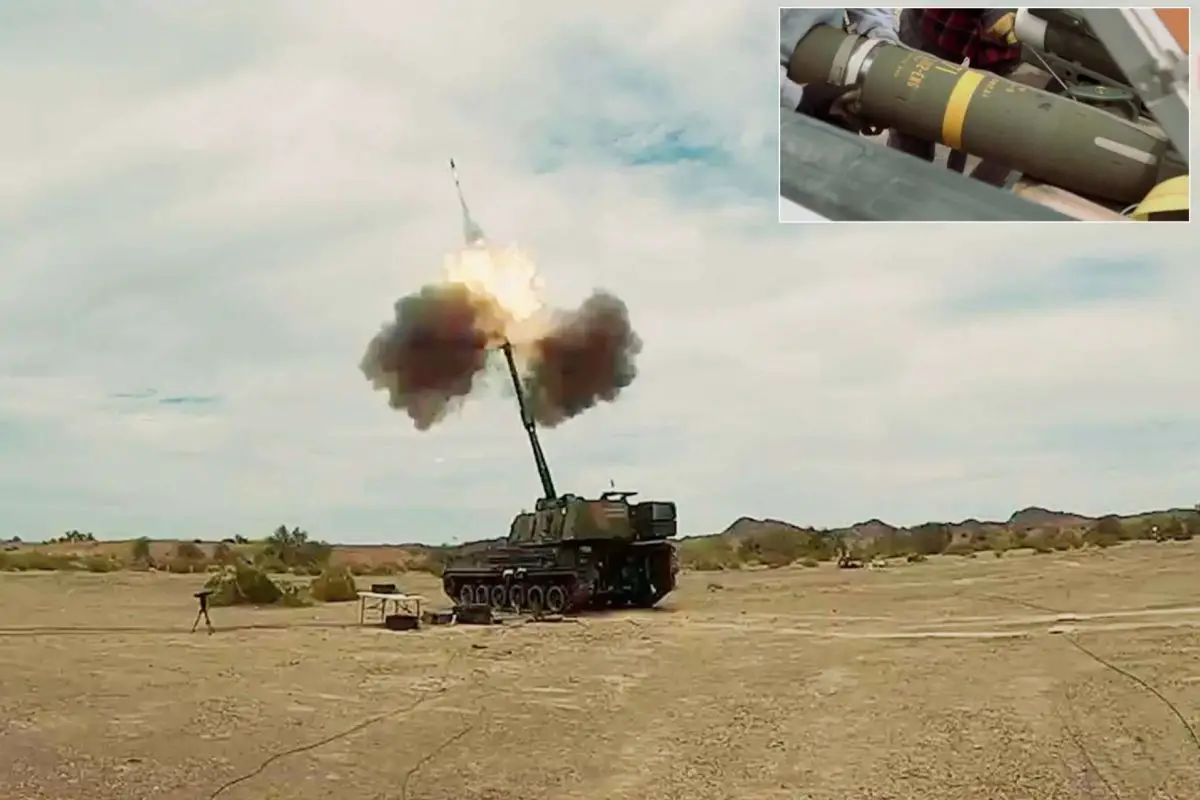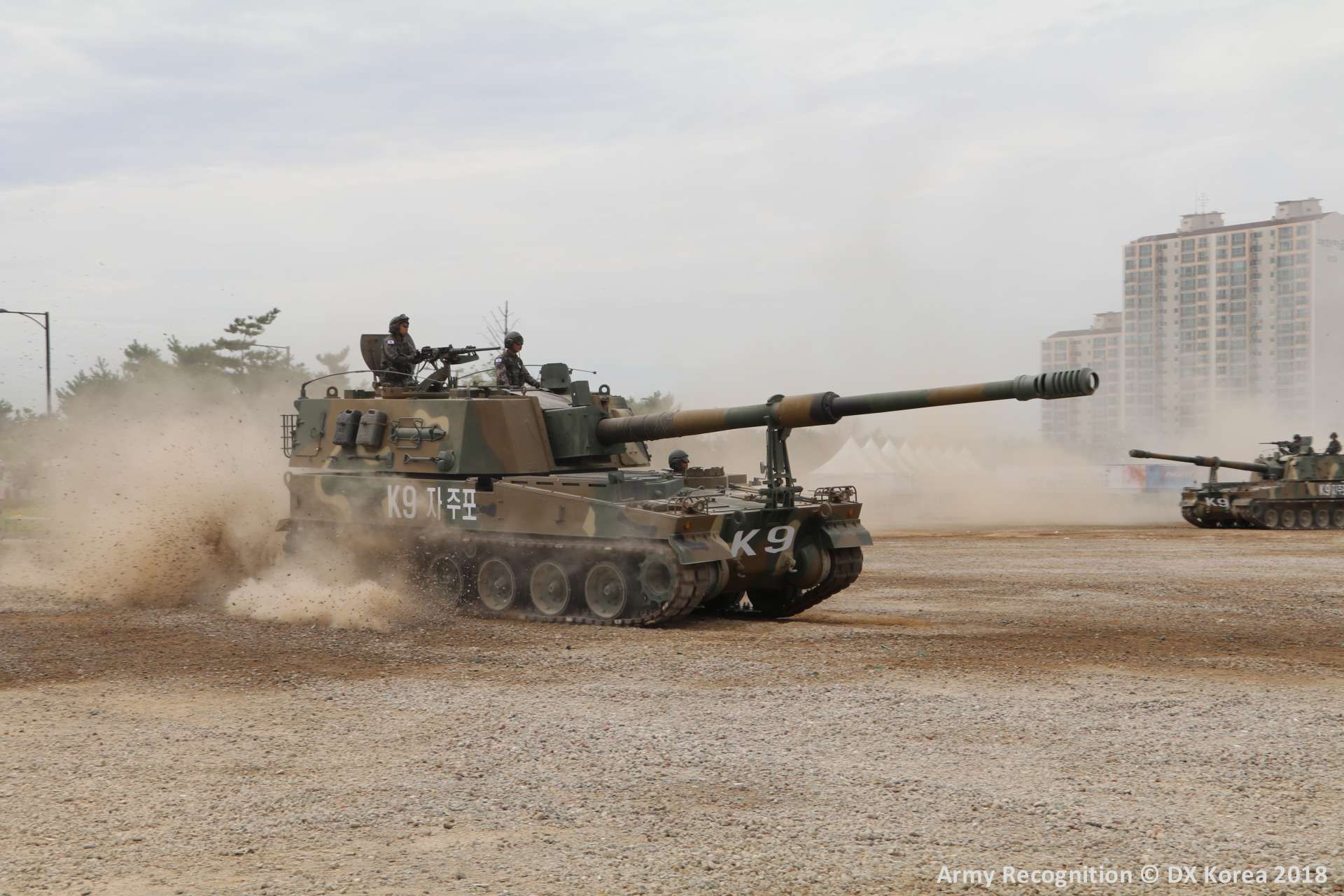Breaking News
Hanwha Aerospace's K9 Thunder successfully tests US M982 Excalibur 155mm precision shells in Arizona.
On August 6, 2024, Hanwha Aerospace announced that the K9 Thunder 155mm self-propelled howitzer had successfully demonstrated interoperability with Raytheon's M982A1 Excalibur precision-guided extended range 155mm artillery projectile. This was confirmed following a live-firing test conducted in April at the U.S. Army Yuma Proving Ground, near the Arizona-California border.
Follow Army Recognition on Google News at this link

The K9 Thunder had successfully demonstrated interoperability with Raytheon's M982A1 Excalibur precision-guided extended range 155mm artillery projectile, specifically targeting an objective nearly 50 kilometers away. (Picture source: Yuma Proving Ground)
The purpose of the test was to verify the K9's compatibility with Excalibur Ib projectiles, specifically targeting an objective nearly 50 kilometers away using various fuze function modes. The test results indicated that a projectile fired from the K9 Thunder achieved a circular error probability (CEP) of less than one meter in the Point Detonating mode, effectively hitting the target. Additionally, another projectile detonated five meters above the target in the Height of Burst mode, demonstrating its capability to engage targets with precision.
This demonstration establishes the K9 as one of the artillery systems globally verified to operate with Excalibur guided munitions, which have been deployed since 2014. The Excalibur projectile, developed through collaboration between Raytheon Missiles & Defense and BAE Systems Bofors, is designed for precision strikes, with an accuracy that confines targets within a radial miss distance of fewer than two meters. This precision extends the operational range of various artillery systems, with the .39-caliber variant reaching 40 kilometers, the .52-caliber extending to 50 kilometers, and the .58-caliber capable of striking targets at 70 kilometers. The Excalibur's efficiency allows it to replace multiple conventional munitions with a single, targeted strike.
The M982 Excalibur is a 155mm GPS-guided, extended-range artillery shell designed to deliver accurate, first-round effects in various weather conditions, with a Circular Error Probable (CEP) of about four meters. The projectile is capable of engaging targets at ranges up to 40 kilometers, making it suitable for precision strikes on high-value targets while reducing collateral damage. First deployed in 2007 during operations in Iraq, the Excalibur has also been used in other conflicts, including in Afghanistan.

The M982 Excalibur is a 155mm GPS-guided, extended-range artillery shell designed to deliver accurate, first-round effects in various weather conditions, with a Circular Error Probable (CEP) of about four meters. (Picture source: US DoD)
An enhanced version, the M982A1 Excalibur, known as Excalibur Increment Ib, entered full-rate production in 2018. This version includes improved jamming-resistant GPS technology and updated software that allows for user-defined projectile trajectories. The M982A1 also offers an extended range, reaching up to 70 kilometers when fired from advanced artillery systems such as the XM1299 Extended Range Cannon Artillery (ERCA). The combination of extended range and precision contributes to the M982A1's role in modern artillery operations.
Raytheon has continued to develop the Excalibur system, introducing variants such as the Excalibur S, which includes a semi-active laser seeker for engaging moving targets in environments where GPS is denied, and the Excalibur N5, a naval variant designed for 5-inch naval guns. These developments reflect the ongoing adaptations within the Excalibur system for both land and maritime operations.
As of early 2024, the K9 Thunder 155mm self-propelled howitzer holds over 50% of the global market share for self-propelled howitzers. Its adoption is due to its technical specifications, including a high firing rate, long-range capabilities, and mobility in various terrains. These features have made it a choice for armies looking to modernize their artillery systems. The recent export of the K9 to Romania will expand its market presence among NATO members, joining other countries such as Norway, Estonia, Turkey, Poland, and Finland, which have already procured these systems. Additionally, the K9 has been exported to Australia and Egypt.

As of early 2024, the K9 Thunder 155mm self-propelled howitzer holds over 50% of the global market share for self-propelled howitzers, due to a high firing rate, long-range capabilities, and mobility in various terrains. (Picture source: Army Recognition)
Introduced into service in 1999, the K9 Thunder offers improvements in range, firepower, and mobility compared to previous artillery systems like the K55 self-propelled howitzers. Since development began in 1989, led by the Agency for Defense Development (ADD) and involving several South Korean companies, approximately 1,800 K9 units have been produced. The K9 project was initially developed to address North Korea's extensive artillery capabilities.
The K9 Thunder is equipped with a 155mm L52-caliber main gun capable of firing various NATO-standard munitions, with a maximum firing range between 18 to 50 kilometers, depending on the ammunition type. It can deliver three rounds in 15 seconds and sustain a firing rate of six to eight rounds per minute. The howitzer is armored with MIL-12560H steel, providing protection against 155mm projectile fragments, 14.5mm armor-piercing rounds, and anti-personnel mines. Powered by a 1,000-horsepower STX-MTU MT881 Ka-500 engine, the K9 can reach speeds of 67 kilometers per hour and has an operational range of approximately 480 kilometers. Its advanced navigation and fire control systems further enhance its operational efficiency.


























